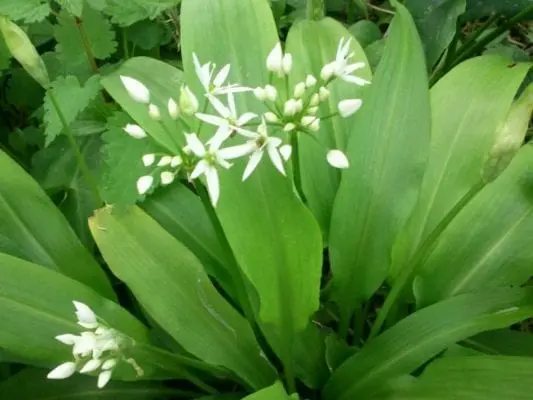Contents
Description
With spring, the season of (ramson) forest wild garlic started, which is listed in the Red Book. The collection and sale of this herbaceous plant is harmful to the environment, but wild garlic can be grown on your site or purchased from the housewives’ personal gardens.
Bear onions, as the wild garlic is also called among the people, is famous for its beneficial properties, in particular for its powerful antibacterial and antiseptic, bactericidal and fungicidal effects, as well as its vitamin composition.
Ramson is widespread in European countries, where it is widely used for food. In particular, in the Czech Republic, England and Germany, it is customary to bake pies and bread with wild garlic, as well as add to salads and hot dishes. However, in European countries, with the exception of Lithuania and Latvia, the plant is not listed in the Red Book, which means it is available for legal purchase.
This is the only plant that is not called a primrose because of the flowering of flowers. And although biologists consider wild garlic to be a “late-spring ephemeroid”, for most of us it is one of the earliest real, not overseas and not greenhouse plants that you want so much after winter. Therefore, when the market offers us green wild garlic with a light taste of garlic, we willingly agree to this offer. Increasingly, wild garlic can be seen in supermarkets.
History of wild garlic

In ancient Rome, Aesculapius wild garlic was considered a good remedy for cleansing the stomach and blood. In medieval medical treatises, wild garlic is mentioned as a prophylactic agent during epidemics of plague, cholera and other contagious diseases.
In the German city of Eberbach, events are held annually under the name “Eberbacher Bärlauchtage”, dedicated to wild garlic and its use in cooking.
The benefits of wild garlic

Outwardly similar to lily of the valley, but smelling like garlic, wild garlic is a real storehouse of vitamins, trace elements, minerals and amino acids.
It contains large amounts of vitamin C, essential oils, phytoncides and lysozyme, and is considered an effective prophylactic agent for acute respiratory diseases. Bear onions stimulate appetite, improve the functioning of the digestive system and reduce the risk of developing thyroid diseases.
Ramson is also often used for vitamin deficiency. It is especially useful to consume wild garlic in early spring, when the body is in dire need of replenishing the deficiency of vitamins and minerals after winter.
In addition, the benefits of wild garlic have been proven for the cardiovascular system. Bear onions, according to The Guardian, stimulate the heart and purify the blood, as well as lower blood pressure and reduce the risk of stroke. Regular garlic, as experts note, also has properties to positively affect the work of the cardiovascular system, but wild garlic has a much more powerful effect.
Harm

Experts recommend not to abuse wild garlic, which, if used unwisely, can cause insomnia, headaches and indigestion. According to various sources, the daily norm of wild garlic ranges from 10 to 25 leaves.
In turn, those who suffer from cholecystitis, hepatitis, pancreatitis, stomach ulcers, gastritis and epilepsy should stop using wild garlic. The plant’s powerful stimulating effect on digestion can negatively affect the functioning of an already inflamed stomach and intestines.
If you do not have these health problems, feel free to add wild garlic to salads, sandwiches, prepare pesto sauce from it and put it in soups.
Healing properties

Bear onions are a good honey plant, bees willingly collect nectar on its flowers. Such honey, besides having a unique taste, is also useful for strengthening the heart muscle. Like all types of onions, wild garlic has phytoncidal properties: a couple of pounded onions kill many pathogenic bacteria.
The medicinal properties of the plant have been known for a long time, since the time of the ancient Greeks, Romans and Celts. On distant voyages, sailors stocked it up as medicine for scurvy. Even now, it is widely used in traditional medicine in many countries. It is believed that wild garlic normalizes metabolism, lowers blood pressure, prevents the accumulation of cholesterol, and cleans blood vessels. Plants cut into gruel are used for coughs and bronchitis, and their decoction is used to treat rheumatism and radiculitis.
Ramson in cooking

Leaves (as well as stems and bulbs) of wild garlic are harvested in spring from the moment the leaves come out and until flowering (at the beginning of summer), thanks to their onion-garlic taste, smell and many useful substances.
Ramsons are used in salads, they can be added to hot dishes (soups, stews), sautéed and, by analogy with spinach, added to omelets, cheeses, pie filling.
By analogy with pesto sauce, you can make this seasoning from wild garlic, replacing basil with it (adding garlic and olive oil).
In general, wild garlic is friends with other spices: black and red pepper, turmeric, nigella, azhgon, rosemary, marjoram, sesame, sage, shambhala … Pickled wild garlic turns out to be very tasty. Also, bear onions can be frozen, salted, insisted on oil. Unlike other spices, wild garlic is not dried, since it loses its aroma, taste, and vitamins.









